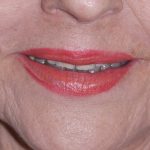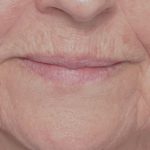1. What can lasers do in plastic surgery that a scalpel can’t?
While many think of lasers like a ‘Star Wars’ saber that cuts through tissue, that is not how it is used in plastic surgery. Lasers are not used to cut tissue. While this sounds theoretically appealing, the effects of such heat on the skin cause exactly the opposite of any benefit…tissue burn and delayed healing. Such an effect is of limited use in cosmetic surgery.
The benefits of lasers in plastic surgery are focused on skin-related problems that are not readily treated by any form of conventional surgery. Cosmetic problems of the skin that can not be cut out without severe and undesireable scarring These include facial wrinkles and scars, excessive hair, unwanted tattoos, visible blood vessels, and brown discoloration.
Because of the greater attraction of heat to darker colors, extreme caution must be used in any type of laser treatment in patients of olive, suntanned, or black skin.

Laser skin resurfacing, commonly called a laser peel, removes the outer damaged layer of skin leaving the way for new cells to appear. This removal and replacement of top surface skin cells can remove benign growths, reduce the appearance of wrinkles and minimize surface scars. The heat from the laser also has a contraction effect on the deeper collagen layers of the skin which can create some degree of skin tightening.
The effectiveness of laser skin resurfacing is a function of its depth. Lasers today can be tuned to the depth of penetration or the amount of skin removal desired. From lighter laser skin peels (often call Erbium or microlaser peels) to deeper CO2 laser peels, the results and amount of recovery can be adjusted to each individual patient’s needs and desires. Because of the extended amount of recovery needed for deeper laser peels, a microlaser peeling approach has become popular. The tradeoff of this approach (healing in a week or less) is that a series of treatments are needed to create the best skin smoothing result.
The newest concept in laser skin resurfacing is that of a fractional approach. (e.g., Fraxel)Fractional means that only a fraction of the surface of our skin is actually treated by the laser. The laser burns less skin surface but goes deeper in the areas that are treated. By leaving small areas of untouched skin, healing is much quicker than it would be otherwise. Whether fractional laser resurfacing is better than non-fractional is a matter of debate. The newest lasers are incorporating both approaches in a single treatment.
Any method of laser skin resurfacing requires a good skin regimen for long-term maintenance of the results. This includes a combination of daily topical skin products combined with intermittent microdermabrasions and light chemical peels.
3. How does laser hair removal work?
Hair growth can be disabled or destroyed by specific long wavelengths of pulsed laser light. The laser is pulsed for only a fraction of a second so that the energy will be absorbed by the hair follicle but not long enough that too much heat is absorbed by the skin. The result is hair reduction or removal without burning the skin. This creates immediate results that will last far longer than shaving, tweezing, waxing, or chemical depilation, all of which are only very temporary.
One of the most important concepts in laser hair removal is that it requires multiple treatment sessions. This is because the laser works only on hairs that are in their active growth cycle. Since other hairs will enter their growth cycles at different times, additional treatments are needed. The number of sessions may be five to eight, spaced four to six weeks apart.
Because the laser treats many hairs at a time, facial areas (e.g., chin, lip, cheek) can be treated in ten to fifteen minutes. Small body areas (e.g., underarms, bikini line) take about half an hour. Larger body areas (e.g., full back, chest, full legs, both arms) usually an hour or more, depending upon the size
of the area and the density of the hair. No matter how it is marketed, laser hair removal is uncomfortable and topical anesthetics are always needed.
4. How do lasers remove tattoos? How effective are they?
Because of differential color absorption, some tattoos are easier to remove than others. For example, black and blue pigments clear the easiest followed by red and greens. Light colors such as pink, orange, yellow and white are often very resistant.
It usually takes six or more treatments to remove a tattoo or reduce it to a shadow or smear. Complete removal cannot be guaranteed or predicted for any tattoo. There is definitely some discomfort associated with laser tattoo treatments and there is often some blistering that develops after a treatment. There is some risk of scarring due to the loss of skin pigment from the absorbed heat.
5. Can I get rid of those tiny blood vessels on my nose and cheeks?
The laser wavelengths needed to treat red colors has been known for decades and served as the color basis for the initial introduction of the concept of laser photothermolysis. (treating color-specific targets) Red spots (angiomas) and small superficial blood vessels are ideal for laser treatments.
Angiomas are quick and easy to treat. The laser turns them initially black (coagulated) and the body simply absorbs them away after a few weeks. Telangectasias are different in that they have flow (you only see them because they have blood flow in them)and are located at different levels in the skin. They are more difficult to treat as it is a delicate balance between enough heat to clot the vessel off but not enough to burn the skin and create a scar. If they are not adequately coagulated, the clot breaks down later and they reappear as the flow returns. Facial telangectasias often require more than one treatment to get the best result.
6. Will laser treatments help scars?
Scars from acne and injury are frequent patient requests for improvements. In some cases, laser treatments can provide scar improvement but it is highly dependent on the type of scar. Laser treatments are frequently given more credit for scar improvements than they often produce.
Deeper laser resurfacing can reduce the appearance of fine superficial acne scars but not deeper ice-pick or saucer-shaped acne scars. More superficial depth laser treatments rarely produce any improvement. More than one laser treatment is usually needed.
Incisional and traumatic scars can be improved with laser resurfacing but only if the problem is one of irregular texture. Excisional treatments are more frequently used and are more effective for the problems of wide, depressed, or raised scars. Scars that are noticeable because of their persistent red color can be improved with red wavelength laser treatments.
.
7. What’s the difference between laser and light treatments?
While both use light as the treatment method, the type of light used is quite different…which also makes what they are effective for quite different also. A laser is high-energy focused light of a single wavelength. Light, or pulsed light treatments, are lower energy, non-focused light treatments. Known as IPL, BBL, and photofacials, they are very effective for brown spots on the face and hands and generalized redness and rosace. When used with other skin treatments, it can also provide for some minor skin texture improvement and tightening.
Dr. Barry Eppley
Indianapolis, Indiana



